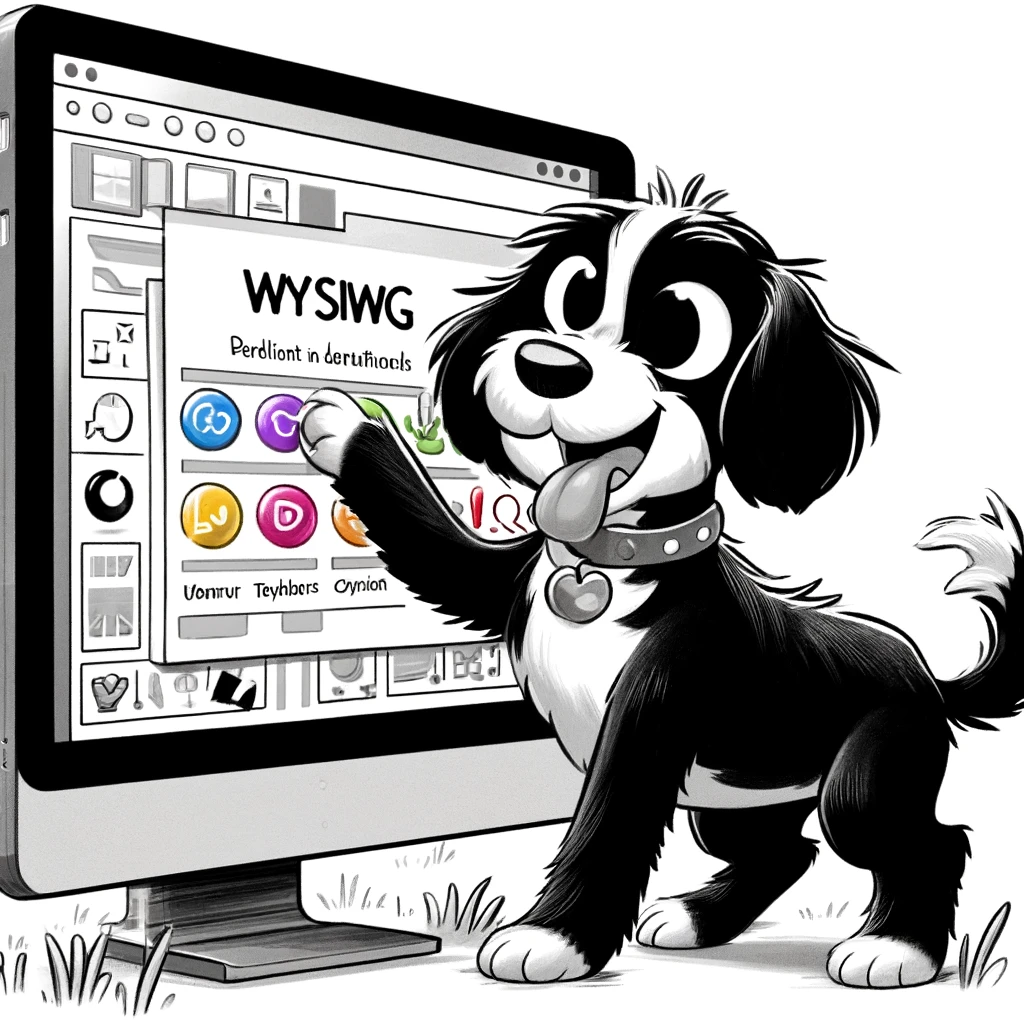Understanding WYSIWYG in WordPress
In WordPress, WYSIWYG—What You See Is What You Get—is an editing interface enabling users to work visually with text and multimedia content. This type of editor is a key part of the user-friendly experience within WordPress, as it lets one manage and format content without a deep knowledge of HTML.
Core Components
- Visual Editor: The default WYSIWYG interface where users can directly manipulate text appearance.
- Text Editor: An alternative mode allowing users to work with native HTML and shortcode.
The WYSIWYG editor’s hallmark is the visual representation of content as you create and manage it. For instance, changing a paragraph to a heading requires highlighting the text and selecting the appropriate option from the toolbar.
Features that highlight the utility of WordPress’s WYSIWYG editor include:
- Ease of formatting: Bold, italicize, or underline text with a click.
- Media handling: Inserting and adjusting images is straightforward.
- Content structuring: Create lists, quotes, and hyperlinks organically.
One significant advantage of the WordPress WYSIWYG editor is the reduction of errors that typically occur when manually coding in HTML. The editor presents a live preview of posts or pages, revealing exactly how content will appear once published.
WYSIWYG in WordPress demonstrates that ease of use does not necessarily mean a compromise in functionality. Through straightforward design, users maintain control over their content presentation, whether they are beginners or experienced webmasters.
Exploring WordPress WYSIWYG Editors
WYSIWYG editors in WordPress facilitate seamless content creation, allowing users to construct and edit pages visually representing the site’s live view. This section examines the intrinsic differences between the Classic Editor and Gutenberg and a selection of widely used third-party WYSIWYG editors.
Classic Editor vs Gutenberg
Classic Editor: It implements the TinyMCE editor, a tool familiar to many for its simplicity and resemblance to word-processing software. This editor has been the backbone of content creation in WordPress for years, providing a straightforward environment for users to craft posts and pages.
Gutenberg: In contrast, Gutenberg introduced a block-based editor where content elements are added as distinct blocks. This progressive step modernizes content construction, enhancing flexibility and design possibilities. Despite the initial learning curve, the WordPress community has increasingly embraced Gutenberg’s block-based approach.
Popular Third-Party WYSIWYG Editors
Elementor: Known for its powerful drag-and-drop interface, Elementor allows for high-level design without coding. It stands out for its extensive widget selection and template library, catering to both novices and professional web designers.
Divi Builder: Divi Builder offers a visual design experience with real-time preview and a vast array of content modules and pre-made layouts. The editor is part of the broader Divi theme ecosystem but is available as a standalone plugin that is compatible with other themes.
Beaver Builder: Emphasizing stability and ease of use, it provides a responsive editing experience and a set of pre-built templates that speed up the design process, making it an attractive option for users at all skill levels.
Thrive Architect: Aimed at conversion-focused websites, Thrive Architect combines an intuitive WYSIWYG interface with a suite of marketing-centric elements. This plugin particularly benefits those building sales pages, opt-in forms, and other conversion-related content.
Divi: Distinct from the Divi Builder plugin, the Divi theme integrates the same visual builder technology, presenting a comprehensive design framework. Users can easily manipulate layouts and optimize every detail of their site’s appearance directly within the theme.
WordPress WYSIWYG editors, whether core options like the Classic Editor and Gutenberg or third-party plugins like Elementor and Divi, offer diverse ways to create and manage content, each with unique features and user experiences.
Enhancing Content with WYSIWYG Editor Features
Utilizing the features of a WYSIWYG editor—standing for “What You See Is What You Get”—can significantly streamline the process when creating or editing content in WordPress. The WYSIWYG editor presents a user-friendly interface that simplifies content creation. Its toolbar has various buttons and options that allow for straightforward formatting. This feature ensures that the text and media elements appear on the website as they do within the editor in real-time.
Users can easily leverage various fonts and styles to emphasize important content and customize the layout. The editing experience in WordPress is designed to be intuitive; users can swiftly drag and drop multimedia elements into their posts, integrating images and videos seamlessly.
Link insertion is another key feature, enabling content creators to highlight references and sources or guide readers to additional information. Users can embed hyperlinks by selecting text and clicking the link button, driving engagement and expanding the scope of their content.
Lastly, the editor’s settings allow for detailed configuration, so users can tailor their workspace to their preferences. Whether adjusting paragraph alignment or applying bullet points, these tools are designed to present a clean, visually appealing final product.
Quick Guide to WYSIWYG Toolbar:
- Bold – Highlight key points
- Italic – Stress importance subtly
- Lists – Organize information
- Link – Connect to other resources
- Drag and drop – Position elements conveniently
- Customize settings – Optimize the editing environment
By mastering these features, content creators can enhance the professionalism and appeal of their WordPress sites.
Advanced Customization and Development
In WordPress, WYSIWYG editors are pivotal for those seeking advanced customization and development. Tailoring the visual interface allows developers to empower users with intuitive tools that enhance the content management experience in alignment with the website’s theme and functional requirements.
Creating Custom Post Types with WYSIWYG
Developers can create custom post types to organize content that does not fit into the default post and page types. By integrating the WYSIWYG editor, they ensure that these custom types maintain a consistent editing experience. For instance, a custom post type might include additional metadata fields configured directly within the editor, streamlining the backend to frontend workflow.
Styling and Theme Integration
Styling the WYSIWYG editor to match the front end of a website is essential for a coherent user experience. Developers can apply CSS to the editor’s content area to reflect the styles of the active WordPress theme. This direct integration helps users preview the final appearance of content during the editing process. For detailed customization, referencing a guide on advanced customizations to the WordPress WYSIWYG editor can provide clear steps and examples.
Extending Editor with Add-Ons and Plugins
Developers enhance the utility of the WYSIWYG editor by incorporating add-ons and plugins. These extensions can introduce features such as shortcodes, custom formats, and advanced media handling capabilities. The modular nature of plugins allows for the expansion of the editor without altering the core files of WordPress. The best available tools are listed on sites exploring the top WYSIWYG WordPress visual editors, showcasing both free and pro options designed to cater to diverse development needs.
Optimization and Best Practices
In WordPress WYSIWYG editors, performance, search engine optimization (SEO), and user accessibility are key to ensuring a site is effective and reaches its intended audience. Adhering to best practices within these areas enhances user experience and can significantly benefit a site’s branding and content management.
Improving Site Performance
A fast-loading WordPress site improves user satisfaction and engagement. One should select a high-performance hosting service as it’s the foundation for site speed. Using a content delivery network (CDN) to distribute the site’s content globally is equally important, which decreases load times. Additionally, implementing caching strategies and optimizing images can reduce the site’s server load and speed up page rendering for users.
- Caching: Use plugins to cache static content.
- Images: Compress without losing quality to minimize load times.
WYSIWYG SEO Strategies
Creating SEO-friendly content with a WYSIWYG editor involves structuring content with headings (H1, H2, H3 tags) and using keyword-rich anchor texts. This enhances the content’s discoverability. It’s crucial to ensure that meta descriptions and titles are optimized for search engines, providing clear information of the site’s content.
- Meta Titles: Should be descriptive and under 60 characters.
- Meta Descriptions: A summary of the page’s content, encouraging clicks from search results.
User Experience and Accessibility
A site’s user experience is enhanced when content is accessible across all devices, especially mobile-friendly platforms. WYSIWYG editors should facilitate easy content management, allowing those without coding experience to maintain consistency with branding. To ensure accessibility, content must be structured logically, and alternative text for images should be used to benefit users with assistive technologies.
- Accessibility: Use alt text for images and proper heading structure.
- Consistency: Maintain font styles and colors aligned with branding.












